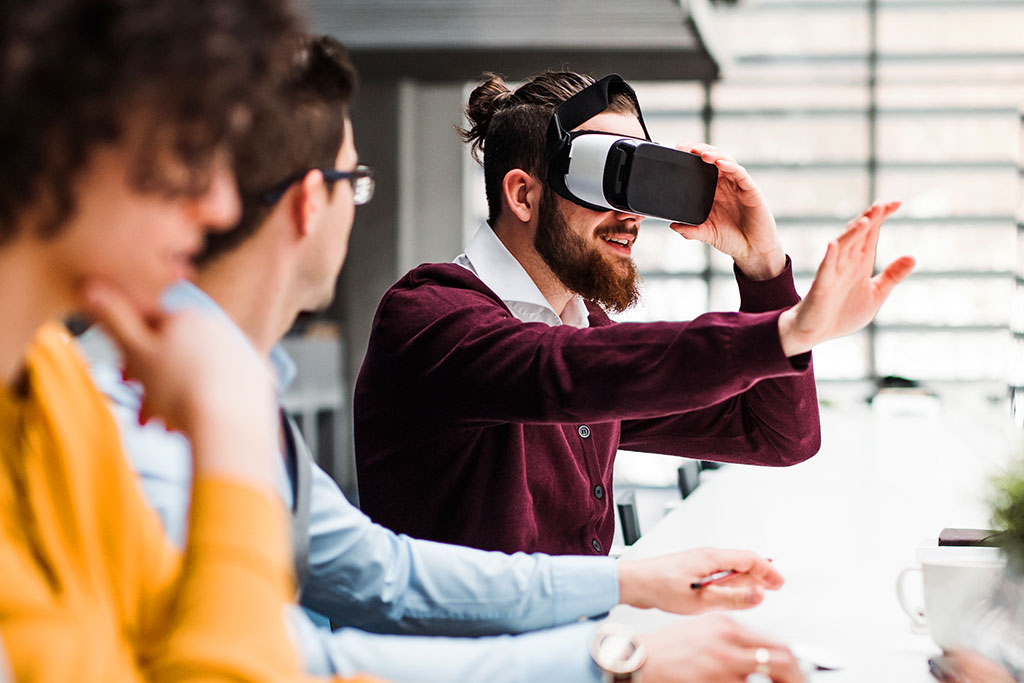Insights
Extended reality and spatial computing: Bridging the gap between the digital and physical world
Author
Ant Morse
Head of Innovation and Account Engagement
Virgin Media O2 Business
8 minutes
12th October 2023
Share this article:
On Thursday 18 September, around 40 participants joined our nineteenth Customer Innovation Forum session online.
The theme for this month was extended reality and spatial computing, investigating how technology is bridging the gap between the digital and physical world.
Hosted by Ant Morse, the CIF is a safe space where leaders from HR, operations, technology and other related functions from some of the UK’s leading organisations discuss technology and innovations that are changing organisations and impacting society.
Formed three years ago, the CIF now boasts 127 members across more than 70 organisations. We operate under ‘Chatham House rules’ in a supportive, non-sales environment where we share experiences and perspectives.
Between us, we aim to look beyond the brochure, discussing the new and up and coming technologies that will shape the way we live and work both now and in the future.
Here are some of the key takeaways from this session.
What is extended reality (xR)?
Ant established some context for the discussion with a short review of the group of three technologies that together make up what has come to be known as extended reality (xR):
- Augmented reality (AR)
- Virtual reality (VR)
- Mixed reality (MR)
Let’s go into each of those in a little more detail.
1. Augmented reality (AR)
AR typically refers to technologies using devices such as handsets and phones that place digital overlays onto the real world.
Parents of teenagers from 2016 onwards will likely remember the craze surrounding Pokémon Go, where mobile devices with GPS could locate, capture, train and battle virtual creatures called Pokémon, appearing as though in the player’s real-world location.
It amassed 147 million monthly active users by May 2018.
Google Glass may not have achieved a universally positive reception, but it was an important proof of concept for what AR could do, displaying information to the wearer using a head-up display.
2. Virtual reality (VR)
VR creates a fully virtual world, blocking out the real world altogether.
It typically deploys headsets together with hand controllers or wands that enable the wearer to interact with the virtual world.
VR’s most widely adopted use cases are in gaming, with the Oculus Quest headset selling 317,000 units in its first quarter following its launch in 2019, as well as more than $5 million worth of gaming content.
Other use cases for VR are niche, although well established, and expected to develop in areas such as training and health.
3. Mixed reality (MR)
MR takes the concept of augmented reality (AR), but instead of the user just seeing the digital overlays in their vision they are able to interact with them.
The technology deploys sensors and cameras within headsets that enable users to interact with holograms by using their hands to pinch, move and manipulate them.
Current examples of MR technology include Microsoft HoloLens and Apple Vision Pro, while potential business use cases include precision work in manufacturing, engineering and construction, healthcare and education.
What makes extended reality (xR) different?
With XR, the technology immerses the user in their spatial environment, interacting with it, rather than simply projecting digital items on top of a physical overlay.
With low latency 5G enabling widespread internet of things (IoT) adoption, the possibilities for the technology are endless, with benefits and use cases for towns, cities, offices, manufacturing environments, healthcare, training and the home.
The role of the smartphone
Ant referred to Mark Zuckerberg’s 2017 prediction that the days of smartphones were numbered and that AR devices would eventually replace them with something like a pair of glasses or even contact lenses.
The main reason why this is unlikely, Ant suggested, is that the smartphone will need to play a significant role, either as the power source or the processing power of xR hardware, in order to keep down its weight and size.
The smartphone may adapt its form factor, but it won’t be replaced altogether.
Forum member questions
Throughout each CIF session, forum members are encouraged to challenge the host and ask questions.
In this session, members asked Ant for his views about use cases for xR and spatial computing, as well as how the technologies might develop.
Here are some of the most interesting questions (and answers) from the session:
Do you think AR glasses could challenge and impact the smartwatch market?
Ant thought that they almost certainly would impact the smartwatch market, although the watch’s haptic capabilities still offer a more complete movement experience.
Ant outlined the concept of the four fields of vision, all of which can co-exist and interact:
- Phone
- Watch
- Glass
- Sound (audio)
Where will the greatest demand for xR be? Will the driver of this technology be commercial, domestic or government driven?
Ant reminded us that any innovation that doesn't solve a specific problem is nothing more than a gadget. Solving problems is only one of the drivers behind this technology, however.
Organisations need to ask: Where is the money?
In consumer terms, there is a vast commercial prize on offer, which is the user’s field of vision. The commercial value of a user will be substantial in terms of advertising and subscription value and the technology could transform the future of search.
Right now, for example, an online search for a local coffee shop will yield a list of results, with outlets competing to be at the top of it, either through SEO or advertising (paid search).
Spatial Computing, however, will enable much more developed search possibilities. If I tap the side of my smart glasses and say, ‘local coffee shop’, I will have lens space for perhaps one or two cafés only.
As businesses, we will be competing for that valuable position or space. Include AI in the mix and an xR search would already know your preferences, values and loyalties and guide you straight to the coffee shop that matches them.
Ultimately the money is a stronger driver than the technology itself and will be the principal driver over the coming years.
Will we see a premium version of subscriptions on wearables where the user will be able to interact without being exposed to adverts?
Ant suggested this was inevitable and that the tech giants are already aware of this. They are no longer competing for a share of their sector spend — they are fighting for a place on our bank statements through subscriptions and digital payments.
However, the technology develops we should expect to see providers offering a range of free, freemium and premium levels of service.
The historical perspective
Like other seemingly game-changing technologies, Ant suggested, xR and spatial computing need to be considered in their historical context.
The Stereoscope was invented as long ago as 1838, for example. It was a device for viewing a pair of separate images, depicting left-eye and right-eye views of the same scene as a single three-dimensional image. It was thought futuristic and groundbreaking at the time.
The Sensorama launched in 1956, an immersive, multi-sensory, film theatre simulator considered to be one of the earliest functioning examples of virtual reality.
And in 1968 we saw the launch of The Sword of Damocles, the world’s first virtual reality (VR) headset, developed by computer-graphics pioneer Ivan Sutherland and his student Bob Sproull.
Ant questioned whether innovation in this technology has been held back in the search for the perfect use case. Not so, he argued, pointing to the collision of several technologies, including AI, 5G and the IoT, that has created the optimum opportunity to exploit what this technology can deliver.
Current market opportunity
So what is the current market opportunity for xR and Spatial Computing?
It’s easy to assume that this is a technology of the future whose use cases will emerge in the years to come. Yet it is being deployed by a broad spectrum of organisations right here, right now, as 38% of members present testified.
Realware
Ant cited the example of Realware, which has developed a range of rugged wearable devices that keep front line teams safe and productive with instant, hands-free access to critical data, documentation and communications.
For networks like ours, a big challenge in that a generation of radio engineers that build and maintain our networks are coming up to retirement. And introducing and training young people to maintain the networks in future is tricky – nothing beats those years of experience out in the field.
With the Realware solution, however, we can connect newly qualified engineers out in the field with the experienced engineers based at home, who can guide them through procedures as though they were standing alongside them.
Northumbrian Water Group (NWG)
NWG has deployed and tested augmented reality headsets that allow technicians to ‘see’ the network of pipes, cables and critical valves beneath their feet when they’re in the field.
Collaboration between water, gas, TV, telecoms and electric companies has helped create a single map of underground infrastructures.
Having sight of what is under the ground without the need to dig a trench has proved hugely beneficial for the health and safety of technicians in the field.
The way forward
What does the future hold? Ant suggested four areas we should keep in focus:
- New hardware: Apple and others will continue to develop their hardware in the race to deliver an affordable mass-market solution
- XR lenses: They are here already but solutions for the problems they might address currently lag behind the technology itself
- AI Assistants: What will be the AI assistant introduction, and when will it come? Again we haven’t yet seen mass-market solutions
- Brain interfaces – What are the implications for technologies such as Neuralink, promising fully implantable brain-computer interfaces that let you control a computer or mobile device anywhere you go? How might they benefit the health, wellbeing and medical needs of people in future?
“If technology is the vehicle for change, innovation is the fuel and society is now the driver.”
Ant Morse
Would you like to join the next Customer Innovation Forum?
Get in touch with your account manager or email Marlene Woodley for details of the next forum and how to join.
Want to speak to one of the team?
call 0800 064 3790


